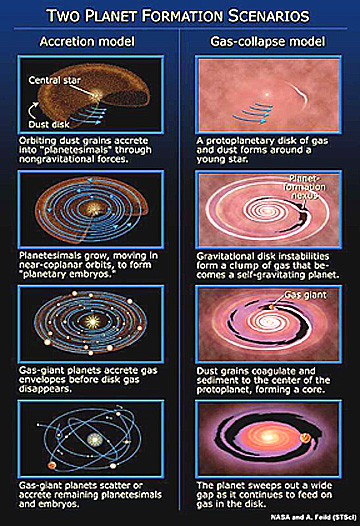PLANETARY FORMATION
In the beginning, scientists trying to explain the origin of planets had only our own solar system to go on, which was based on the assumption that there could be only result - a solar system like ours. What we needed was another planetary system to confirm our theories. This only came in 1995 with the discovery of a Jupiter-like planet circling the sun-like star 51 Pegasi.
As usual, things don't always go as planned in astronomy. Thus instead of answering questions it only serves to pose even more. It was either modify the current theory to satisfy both systems, or think of a new one.
The current theory was drawn up by the German philosopher Immanuel Kant in 1755. He describes what is now called protoplanetary disks as a region of space extending from the centre of the sun to unknown distances, contained between two planes not far distant from each other. Within this disk, the attraction of the elementary matters for each other draws particles together to form larger and larger objects, eventually creating planets.
Now, this simple theory goes on with heavier elements gathering nearer the sun and lighter ones further out. Thus the result is the current model of the solar system with Mercury, Venus, Earth and Mars near the sun while the gas giants are much further out.
Here are two examples of how this happens

However, this is where the standard model stays, in our solar system. With the extrasolar (meaning outside our solar system) planet, it appears to be at least 150 times more massive than Earth, yet it orbits 20 times more closely to its parent than Earth circles the sun. Hence convention goes out the window.
There are many hypotheses to solve the current situation, but it's all only speculation. As always, until new discoveries are found can the theories be confirmed.
LOOK UP TO THE STARS...
Credits to Tom Yulsman